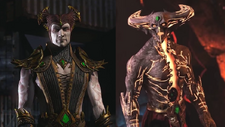The boss is the final opponent that the player must face at the top of the battle plan after having braved their way through the ranks of other fighters and usually the final "test" to the player's skill in the game. Final bosses are often computer-controlled only, and thus, are unplayable. Bosses are always inhuman, often demonic, compared to the cast of characters. In addition, they often possess several advantages over the normal characters such as higher resistance to attacks and much more prominent strength. Victory over the boss results in their climatic demise, followed by the selected kombatant's ending, in which at times, may be canon. On rare occasions, the player may unlock a prize for their success.
Bosses
Mortal Kombat

Shang Tsung as he appeared in MK:SM in his attire from Mortal Kombat.
Shang Tsung has the first boss role in the entire series. Despite his decrepit appearance, Shang Tsung is a force to be reckoned with. His main form of attack involves launching fireball volleys at his opponent, with each of them being very damaging. In addition, he has the ability to morph into any other character in the game, including Goro (though he will not morph into Reptile). When he is defeated, the numerous souls of the kombatants will slide out of his body and vanish as he convulses in pain until he dies.
Mortal Kombat II

Shao Kahn is even more fierce and intimidating than Shang Tsung was. Unlike him, Shao Kahn relies on brute strength, thus most of his attacks are melee oriented, but have long reach and can seriously damage the opponent if off guard. He mainly attacks with single punches and kicks along with a powered charge that comes out rather abruptly. Upon his defeat, he will scream "NO!" in terror as the backgrounds change before he petrifies, cracks, and explodes.
Mortal Kombat 3
Shao Kahn - The Pit III
Not much has changed about Shao Kahn in Mortal Kombat 3, though he has replaced his javelin with an eye blast and features a new rising charge attack. His death in this is similar to MKII with the exception of his body being enveloped in soul energy with power being siphoned out of his body until it reaches a zenith and causes his temple to explode, taking the portal from Outworld with it. In Ultimate Mortal Kombat 3, it simply cuts away to Scorpion's Lair where the light of the blast can be seen. In the N64 version of Mortal Kombat Trilogy, the arenas do not shift. Instead, the souls of the kombatants fly out from his body.
Mortal Kombat Mythologies: Sub-Zero
The fallen Elder God and Quan Chi's master. Shinnok slowly hovers towards the player, launching projectiles while at the same time, keeping himself safe from counterattacks by erecting an energy shield. However, while it is possible to freeze him, the shield will persist still. The only way to deal with Shinnok is accomplish your original mission of taking the Amulet from him by freezing him and using the teleporter to bypass the shield and snatching it from him. Doing this will anger the fallen Elder God as he transforms into a towering demonic creature, now relying on brute force as he bashes the floor with his fists towards you. You can either stay and fight him or take the recently opened portal and escape. The only sure-way method to defeat him is to stock up on regenerative items to use the Polar Blast until he falls.
Mortal Kombat 4

Shinnok in his Mortal Kombat 4 attire in Mortal Kombat: Armageddon.
Shinnok - Fire Well/Elder Gods' Arena
A fallen Elder God who first appeared in Mythologies: Sub-Zero, Shinnok has returned with a vengeance, waging a war against the Elder Gods and succeeds in slaughtering most of them.
The first boss character to be initially playable without having to fulfill any conditions. Unlike other bosses before him, he is less intimidating, being the same size as the other playable characters and no original moves of his own, though he possesses the ability to use other characters' movesets. When he is defeated, his face stretches out and shatters, leaving behind a mutilated head as he plummets into a fiery portal leading back to the Netherrealm.
Mortal Kombat: Deadly Alliance
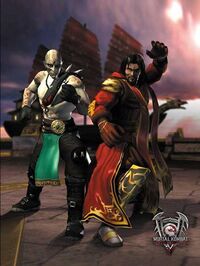
The Deadly Alliance.
Unlike the previous games, the final boss in this game is actually split into two separate battles, with the order being predetermined by the storyline of the player's selected character. After an unusually total absence from the previous Mortal Kombat game, Shang Tsung returns as one of the bosses, for the first time since the original Mortal Kombat. Though he lacks the ability to morph into other characters, he still possesses dangerously fast combos, variations of his classic fireball attack, and he can also power-up from the soul chamber. Shang Tsung's partner in the Deadly Alliance, the sorcerer Quan Chi, is also a formidable opponent. He uses a devastating combination of sweeps, fast melee attacks, and a deadly expertise of his broad swords to make life miserable for the player. Like Shinnok in Mortal Kombat 4, both Shang Tsung and Quan Chi are playable in the game. For the first (and only) time in a Mortal Kombat game, they are also the only final bosses against whom the player can perform a Fatality on when they are defeated, although the congratulatory picture shows their bruised and broken bodies with their souls being absorbed into the Soulnado.
Mortal Kombat: Deception
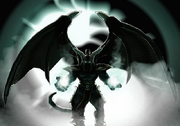
Onaga the Dragon King.
The very first blatantly non-human boss in the series. The Dragon King is much more imposing than any other final boss encountered at this point and this fight requires a combination of both strategy and skill. While Onaga can be damaged normally (except for immunity against projectile attacks), Onaga's defense can be weakened by touching any of the Kamidogu lying in place at the edges of the arena. Onaga cannot be defeated by a deathtrap and the Kamidogu cannot regenerate. Like Shao Kahn, he relies on brute strength, although his attacks tend to be somewhat quicker as he can even perform small combos. He can also breathe fire, either firing off a single fireball or a stream of flame that can stun and burn the opponent. He also takes advantage of his wingspan, generating powerful gusts of wind to create gaps between his opponents as well as being able to fly. Upon his defeat the screen darkens and his body ignites, screaming in pain before he explodes, leaving only his head behind.
Mortal Kombat: Shaolin Monks
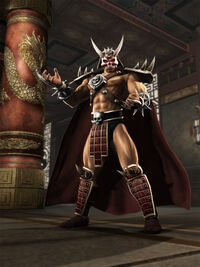
Shao Kahn is much more difficult in this battle than he was in MKII. He possesses his MK3 moveset, and in addition, Shao Kahn can grab the player now and recovers much faster. The safest way to deal damage is by use of projectile attacks and Kintaro's disembodied head. Once Shao Kahn's health is half depleted, his helmet will shatter and he will begin to make use of his Wrath Hammer only. He makes single, swift upward and downward swings. After at least 4-5 swings, he will begin spinning around with the hammer extended, and the attack can juggle as well, making the attack even more hazardous. After a period of swinging, he will fall into exhaustion. At random, this is merely a hoax. If approached a close range, Shao Kahn will automatically counter with a grab-and-throw attack. Upon his defeat, Raiden is shown to be the one to turn his body to stone with a torrent of lightning before Liu Kang and Kung Lao pulverize him with flying kicks, leaving his soul to escape to parts unknown.
Mortal Kombat: Armageddon
Transformed for the events of Armageddon, Blaze is the most powerful entity in the entire franchise at this point. Having become a maelstrom of fire and destruction, Blaze uses long reaching attacks with swipes and kicks. Unlike his original form, Blaze strangely does not implement projectile attacks, but has the ability to teleport, something that other final bosses before him lacked. While he is a playable character, Blaze is the only boss character in the game who cannot be finished off. Upon his defeat, he dies in the exact same manner as Onaga, though in an earlier version, he simply falls over.
Mortal Kombat vs. DC Universe
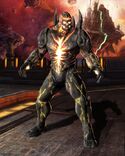
The nightmarish merger of Shao Kahn and DC Comics' Darkseid. He is essentially a fusion of the two in every sense of the word, having a combination of their movesets which utilize a series of brutal attacks and swift charges. Upon his death, his body expands and inflates before exploding and leaving behind a puddle of lava.
Mortal Kombat (2011)
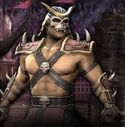
Shao Kahn - Kahn's Arena
Shao Kahn - Rooftop at Dusk (Story Mode)
Arguably the hardest incarnation of Shao Kahn ever seen. He is as he was in his original MKII incarnation with a few differences. Unlike previous boss battles, there is no time limit, making this a death match. While he still uses powerful punches and kicks, he makes much more use of his hammer, even going so far as to chuck it at his opponents to stun them as well as making more frequent use of his charge attacks. Most notorious though is now having invincibility frames in his attacks, allowing him to continually punish his opponents with nigh impunity. Unlike the other final boss encounters from previous games, Shao Kahn has his own set of Fatalities which he will use if the player loses to him on Medium or higher. Upon his defeat, the kombatant will perform a series of painful attacks with the last one knocking him down, causing him to subsequently explode, complete with him screaming his usual "NOOOO!".
Mortal Kombat X
In contrast with his performance as a final boss in Mortal Kombat 4, this version of Shinnok is doubtlessly way harder than his one in the previously mentioned game, yet arguably under such other bosses like Shao Kahn or Onaga in difficulty terms. He is fought in the Jinsei Chamber, where he will battle you using any one of his three variations. Imposter allows Shinnok steal a specific special move from his opponent. Bone Shaper allows him to craft bone-like weapons for long-reaching melee attacks, and Necromancer allows him to summon his familiar giant skeletal hands to grab and crush the player. For the first time in the series, Shinnok will assume a much more powerful final form by using his Amulet to absorb the Jinsei's power, thereby taking the realm of Earth's power for his own and transforming him into a demonic visage called Corrupted Shinnok; this is a callback to his appearance in Mortal Kombat Mythologies: Sub-Zero. From here, the battle is a one-round match and he is much more like traditional final bosses, possessing high priority moves that can dish out a lot of damage. Though he uses his brute strength, his throw has him plunge the opponent's head into his abdomen, burning their face with the flow of lava in his body. His most powerful and notable move is a beam of fiery energy from his chest, which can not only be spammed in quick succession, but even has an enhanced version that can hit the opponent twice. Both versions come out extremely quickly and reach just as quickly as well, making him an extremely difficult opponent in the higher difficulties. Upon defeat, the player character grabs the Amulet and violently rips it out of his body. He then falls to the ground, bereft of power before being slammed by a blast of purified energy. He is then lifted into the air, energy building up until he explodes into pieces.
Mortal Kombat 11
The very first female final boss of the series. Kronika is the Keeper of Time and the Architect of the Universe whose power supersedes that of the Elder Gods, being the mother of Shinnok and Cetrion. She is the ultimate conspirator of all every conflict that has ever transpired in both timelines and countless others in order to perfect her vision of cosmic balance. A stark contrast to every other boss before her, Kronika exclusively uses her powers over physical prowess to fight, attacking with various energy blasts and beams while being able to teleport by reducing her form to sand and reappearing elsewhere. Her time powers also allow her to reverse the previous action of her opponent. When her health has hit below a certain point, she retreats to her Hourglass and summons a random, much weaker character to fight in her stead, disintegrating into sand once defeated. Due to her tampering with time, the arena shifts to the prehistoric era and she may incite the wrath of a nearby Tyrannosaurus rex to attack her enemy. Once her health hits below yet another point, she retreats again and summons another fighter before reversing time to the very beginning of time, now summoning a meteor to attack.
When she is defeated, the fighter knocks her into the Hourglass, which shatters almost immediately upon impact. The flying shards from the explosion slice her body apart, leaving her with only her torso and an arm. As she attempts to crawl over to her crown, the Hourglass begins to repair itself with the shards flying back, slicing her skin along the way until a much larger one splits her head open, sucking the entirety of her back in and vanishing into nothing. Her Fatality has her tear her opponent apart in various ways such as flaying them or splitting them in half, reversing time to restore them only to repeat their suffering on an endless loop.
Mortal Kombat 1
Titan Shang Tsung and Quan Chi - The Pyramid
A new and more powerful Deadly Alliance has returned from the splintered timelines in a parallel reality where he destroyed Liu Kang following the conclusion of the previous game, consisting of god-like versions of the sorcerers. Titan Shang Tsung is responsible for the compromise of Liu Kang's New Era and wishes to eradicate all life in his new timeline, absorb it and pervert all of reality with his brand of evil.
Much like in Deadly Alliance, Titan Shang Tsung plays no differently from his playable counterpart. He retains many of his classic moves from Mortal Kombat 3 and has the ability to shapeshift into his opponent at will as well as being able to shift into an older version of himself to alter the properties of his attacks, acting as a stance character. He is also armed with arm-mounted claws to slice his opponents. His Kameo, Quan Chi, will also be called to enhance his attacks and support him.
Upon defeating him, the chosen fighter and their Kameo unleash a barrage of savage attacks, knocking them to the edge of a soul pit before uppercutting them into the chasm, their bodies disintegrating in the descent and unleashing a powerful burst of soul energy.
Sub-Bosses
The sub-boss precedes the final boss of the game. It is usually a completely non-human creature that dwarfs the other characters in about every sense of the word; speed, strength and size. They tend to put up more of a challenge than the last boss on several occasions.
Mortal Kombat
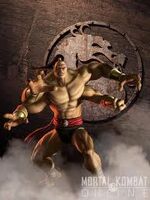
Goro in Mortal Kombat: Deception.
The first boss of his kind to appear in any fighting game. He immediately challenges the player right after the last Endurance Match opponent is defeated as the game will not even switch to the Battle Plan. Instead, his roars and occasional tremors can be heard as the battle goes on, giving him a truly intimidating, frightening sense of air. The Prince of Shokan is an intimidating four-armed behemoth with devastating attacks. A mere single punch can easily take off nearly a quarter of health. He also launches fireballs from his fist and stomp on the opponent as well. His favorite technique employs the use of his lower arms to grab the player and then proceeds to relentlessly smash them with his free arms.
Mortal Kombat II
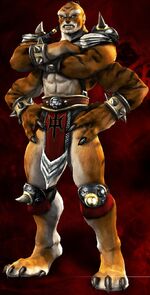
Kintaro in Mortal Kombat: Armageddon.
An even more ruthless warrior than Goro, Kintaro is a much faster and more powerful foe. While sharing similar attacks with Goro, Kintaro has his own uppercut, which sends the opponent high into the air and offscreen. He is also the first to employ the Teleport Stomp in where he leaps high into the air and comes back crashing down on the opponent, stomping them for good measure, as well as spitting out fireballs.
Mortal Kombat 3
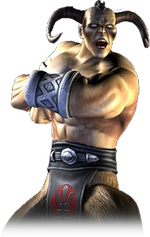
Motaro in Mortal Kombat: Armageddon.
Possibly the most intimidating sub-boss in the franchise yet. Motaro carries the traits of his predecessors but much more powerful and with a few other tricks, possibly making him the most difficult sub-boss in the franchise. He has the ability to freely teleport, allowing him to immediately counter attacks and has a sweep attack that employs the use of his tail, covering the entire floor. His most notorious trait is the ability to automatically reflect any and all projectiles thrown at him without needing to do anything.
Mortal Kombat Mythologies: Sub-Zero
Quan Chi is a very powerful sorcerer who originated from the Netherrealm. He serves the fallen elder god Shinnok. Looking to free his master from his confines of the Netherrealm, Quan Chi tricks the elder Sub-Zero into retrieving Shinnok's amulet for him. Throughout the battle, Quan Chi runs in to close the distance so he can perform a very damaging combo on you. He can shoot projectiles at you from medium range and also has a telekinesis move that will either lift you in the air for a free uppercut attack or pull you in to deliver a devastating combo. If you spared Sareena earlier on in the story, she will appear to aid you when Quan Chi's health is very low and uppercut him off the ledge to his supposed death.
Mortal Kombat 4
- Quan Chi (Arcade Version)
- Goro (Home Version only) - Goro's Lair
Goro returns for the home ports of MK4 as a sub-boss, retaining his moves from the first game. He can also be unlocked as a playable character by beating the game with Shinnok and then selecting Shinnok while using the Hidden option and then pressing Run and Block.
Mortal Kombat: Deadly Alliance

Moloch in Mortal Kombat: Deadly Alliance.
One of two Oni employed by Quan Chi as insurance. Moloch is a tough and somewhat persistent foe. He utilizes the mace chained around his arm and swings it about in wide arcs and can even fire projectiles.
Mortal Kombat: Deception
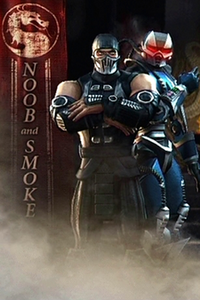
Noob-Smoke in Mortal Kombat: Deception.
Noob-Smoke - A deadly tag team born from Noob Saibot's takeover of the The Brotherhood of Shadow clan and using the former Lin Kuei cyborg Smoke as his enforcer. Similar to the Endurance Rounds of previous entries, the player must fight both characters at once. Unlike said battles however, the characters are treated as a single entity, sharing the same bar. Both have their own singular style and switch when said styles change. Noob Saibot employs the nimble and quick Monkey style for combo attacks while Smoke utilizes the powerful Mi Tzu style which employs single, but effective strikes. They can be unlocked as playable characters through the Krypt.
Mortal Kombat: Shaolin Monks
- Kitana
- Mileena (secret)
- Jade
- Reptile
- Baraka
- Sub-Zero
- Goro
- Scorpion
- Inferno Scorpion
- Shang Tsung
- Kintaro
- Ermac (secret)
- Kano (secret)
Mortal Kombat: Armageddon
Mortal Kombat vs. DC Universe
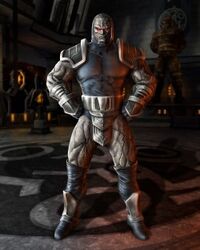
Darkseid.
Coupled with his evil intentions of enslaving the universe, Darkseid represents one of the single greatest threats to be present in the DC Universe.
Mortal Kombat (2011)
- Shang Tsung - Shang Tsung returns for the first time in nearly two decades in his elderly form and he is still as deadly as he was back then. While he plays somewhat normally like the playable version, the boss version can morph into one of three random characters at will (one will always be the player's current character or both in Tag Ladder). He also employs frequent use Enhanced attacks and swift, tricky combos to knock his opponents into submission.
- Goro or Kintaro (Who the player fights is chosen at random) - Both characters are relative unchanged from their original incarnations, but like Shao Kahn, possess invincibility frames while attacking, but are arguably easier to beat than before. If defeated by either Shokan in Ladder with the difficulty set to Medium or higher, they will perform a Fatality at random. While normally unplayable, they do have a defined moveset and even Fatalities with names given to them. A single event in Challenge Tower called Gor-owned allows the player to assume the role of Goro through five Endurance matches.
Mortal Kombat X
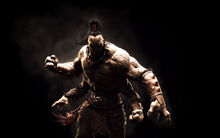
- Goro - Goro returns as a sub boss, regardless of whether or not he's downloaded by pre order or DLC. Goro has access to his variations and one will be picked at random before fighting him.
Mortal Kombat 11

- Cetrion - Kronika's Hourglass (Story Mode) - She is fought in story mode just before you fight Kronika. Cetrion's moveset is mostly based on zoning, with many abilities that can keep the opponent away from her, preventing any engagement in hand to hand combat. She can emit shockwaves, blast water beams, fire pure energy, incinerate opponents from below, only moving in to deliver a very damaging combo. Her fatal blow can be cast from any range making her very dangerous to move in on when she is in that state.

